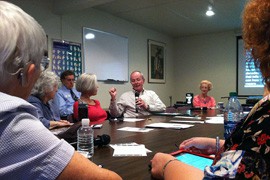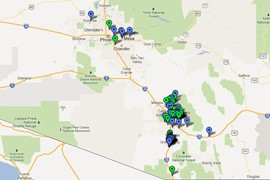Cronkite News has moved to a new home at cronkitenews.azpbs.org. Use this site to search archives from 2011 to May 2015. You can search the new site for current stories.
Tucson effort taps into national trend of ‘looping’ for hard of hearing
TUCSON – When Charles Spencer moved here two years ago, he visited churches and hoped, with his hearing aids, he would be able to understand the sermons.
“Once I was particularly moved and closed my eyes to reflect and realized I couldn’t hear any longer,” Spencer said. “I was depending on body language and facial expressions to help me.”
Then Spencer visited St. Francis in the Foothills United Methodist Church, where a system called looping connected his hearing aids to the PA system through a wireless signal.
“I just kept having to pinch myself,” he said. “I’m really hearing.”
St. Francis is one of 41 churches, offices and meeting rooms in Tucson that are looped.
That means these places have created an electro-magnetic loop with wire around the perimeter of the room, connected to an amplifier and the public address system. When a person with a hearing aid flips a tiny switch to the telecoil setting, he or she can hear what’s being said into the microphones without any background noise.
Spencer was so determined to help others hear better, he now installs looping systems – sometimes at no charge. And he’s active in the Adult Loss Of Hearing Association (ALOHA), the group behind “Let’s Loop Tucson.”
The initiative began in 2006 but has been picking up traction as more of southern Arizona’s public venues install loops, and as more people with hearing loss find out about looping, according to George Ghorpade, the president of ALOHA.
“When I came to ALOHA, I’d had hearing aids for 25 years,” said Ghorpade, who is considered profoundly deaf. “But I had never heard of looping. It was an amazing experience.”
A 2007 state law requires audiologists in Arizona tell patients purchasing hearing aids about the telecoil option that makes looping possible.
Loops are a better return on investment than alternatives such as systems based on FM or infrared signals, which often include headphones and receivers, according to Loretta Butler, ALOHA’s office director.
“An FM system might offer help for 10 people, but with a loop, 200 people in a venue can hear by switching their hearing aid to the telecoil setting,” Butler said.
Some with hearing loss like the effect so much they loop rooms in their homes so that they can listen to TV, radio and phones better.
“It changed my world,” said Dixie Nixon, an ALOHA member who had her den looped. “I had just given up.”
A small room can cost less than $200 to loop; a larger facility could cost more than $1,000.
Arizona is home to more than 700,000 people with hearing loss, according to the Arizona Commission for the Deaf and the Hard of Hearing.
When first confronted with hearing loss, most people don’t want to talk about it, said Spencer, who knows from experience.
“I’m a pretty social, outgoing person, and I was starting to unplug,” he said. “Your self-esteem goes down.”
Looping could be a life-or-death issue, Spencer added.
“When people disconnect from their social networks,” he said, “it affects them emotionally, spiritually and physically.”
Looping is taking off nationally, supported by not only those with hearing loss but also by audiologists.
“We have houses of worship, we have senior residential facilities, bus lines, taxicabs, Amtrak – a lot of different segments that are interested,” said Brenda Battat, executive director of the Hearing Loss Association of America. “It’s cost-effective, has a universal standard and it’s seamless.”
Looping could gain even more popularity as the population ages.
“With 78 million baby boomers getting older and one out of three experiencing age-related hearing loss, boomers will push looping forward,” said audiologist Juliette Sterkens, in a phone interview from Kansas City, where she was attending a hearing loop conference.
Now, Ghorpade, accompanied by his service dog Rover, is pushing to get more public venues in Tucson looped, and he just started an ALOHA chapter in Oro Valley. When hard-of-hearing people experience a loop and how clear it is, they want it everywhere, he said.
“People don’t want to wear headsets, they don’t want it to cost a lot and they want something that works,” Ghorpade said.
If every person with hearing loss knew about its convenience and effectiveness, looping would be more common, according to Brenda Battat.
“There’s nothing like seeing someone trying it for the first time,” Battat said. “Because they’re always blown away by how much better they can hear, and it’s quite an emotional moment.”









